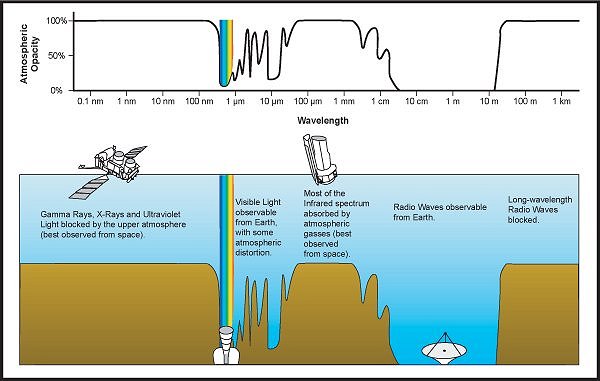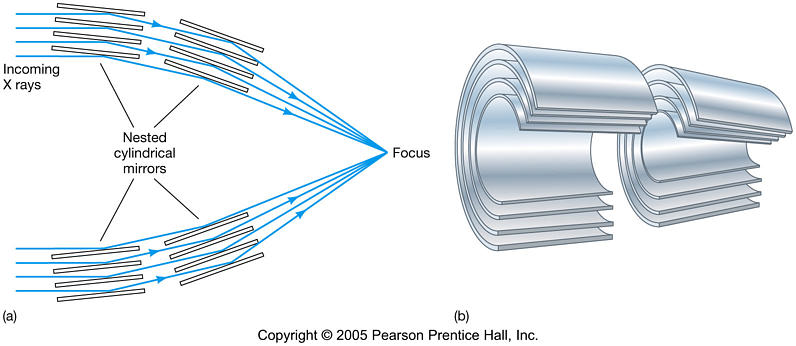
You probably recognize this image. You see something like it whenever you look up at the sky. Some days are clearer than others—some, you might even see a completely blue sky—but regardless, you know that this is an image of our atmosphere.
But do you know just how much your atmosphere does for you?
We’ll talk about how it protects you from space rocks later on. For now, consider the energy from our own sun. The sun doesn’t just send visible light our way—it operates in all wavelengths of the electromagnetic spectrum.
Some of those wavelengths are harmful, like gamma rays, X-rays, and ultraviolet radiation. Others, like infrared radiation, microwaves, and radio waves, are perfectly fine.
The atmosphere doesn’t really pick and choose which wavelengths get through to the surface. It blocks out some radiation it doesn’t need to. At least it protects us from the harmful wavelengths.
But that’s bad news for astronomers, because those wavelengths still contain useful information about the universe.
So how to we capture and analyze them?
The secret lies in infrared and high-energy astronomy.

Infrared astronomy is the practice of analyzing infrared radiation—radiation of a slightly longer wavelength than visible light.
High-energy astronomy, on the other hand, focuses on wavelengths shorter than visible light. Those are the harmful ones. Ultraviolet radiation, for instance, is responsible for sunburns.
All of these forms of radiation get blocked by the atmosphere, as you can see in the graph below.

Ground-based (or terrestrial) telescopes only include visual (optical) ones and radio telescopes. In order to observe in the other wavelengths of the electromagnetic spectrum, we have to get to them before they get blocked.
In other words, we need to get above the atmosphere. Into space.
You probably already know of at least one space telescope—Hubble. (You definitely know about that one if you read my last post.) Hubble can observe in the visible spectrum, but also the near-ultraviolet and near-infrared.
To get more observations in the ultraviolet or infrared, you need a telescope that can specialize in either of those wavelengths. Not one that’s mostly just an optical telescope.
The problem with infrared astronomy is in the job title. Infrared radiation is more commonly known as heat. And Earth may not emit its own light like the sun, but it sure emits a lot of heat. That’s why plate tectonics work. It’s why volcanoes erupt.
Earth, for infrared astronomy, is like light pollution or radio noise for optical and radio astronomy. It sort of drowns out all the other heat data the telescope might try to take a look at.
Which is why infrared telescopes do their best work away from Earth.

The Spitzer Space Telescope is one such telescope. It was launched clear out of Earth orbit and is allowed to slowly fall behind us as it orbits the sun.
Spitzer, like all infrared telescopes, has to keep cool—otherwise, its goal to literally absorb as much heat as possible would do no favors for its fragile instruments. It’ll operate right up until its coolant runs out.
You might also notice that Spitzer has a weird shape. It’s not your basic cylinder, like an ordinary optical telescope.
Well…Earth isn’t actually the biggest source of infrared in the solar system. It’s the closest, and thus the one we have to worry about the most. But the sun is an even more reliable source, so Spitzer has to observe from behind its very own sun umbrella.
It’s not exactly umbrella-shaped. It’s actually called a sunscreen. But it serves the same basic purpose. Spitzer has to keep cool…in the shade.
Then, of course, there’s high-energy astronomy—starting with X-rays.

The X-rays that an X-ray telescope collects are no different from the ones your doctor collects to see what’s wrong with your bones. Since X-rays carry much more energy than visible light, they can pass through things that visible light can’t.
Like your organs and other soft tissues.
Fortunately, X-rays can’t pass through the atmosphere, or we humans would be in trouble. And fortunately for astronomers, there are ways to collect X-rays in space. But it’s difficult.
The job of any telescope, no matter what radiation it collects, is to focus that radiation by reflecting it at different angles. The radiation comes to a focus wherever its parallel rays cross one another.
The problem with focusing X-rays is that they have so much energy, they can pass right through most mirrors.
Now, telescopes like the Chandra X-Ray Observatory are made of cylindrical mirrors.

At first glance, Chandra looks like any optical telescope. It’s cylindrical like a reflector. But on the inside, it’s a whole new brand of weird. Here’s the idea.

Here, the mirrors in the left diagram are the same as the mirrors in the right diagram. Notice they’re angled the same way. The left diagram shows you how the mirrors reflect the X-rays, and the right diagram shows you what the mirrors actually look like.
An X-ray telescope is made up of the nested mirrors you see on the right. In the back of Chandra, they’re angled much more dramatically—as you can see in the diagram.
X-rays can pass through the cracks between these nested mirrors. They get reflected off the inside surface and eventually aimed at the focal point, or the focus.
This process is worlds apart from the way optical reflecting telescopes collect light. But then, it’s much simpler when we’re working in the visible light wavelengths—we only have to reflect the light off a primary and secondary mirror, and we’re done.
X-rays may be hard to collect, but it’s worth it.

X-ray images let us observe outer space phenomena we wouldn’t be able to see otherwise. Most objects in the universe emit all forms of radiation, but X-rays hold information that other forms of radiation don’t.
That’s…ahem…why we went to the trouble of giving them a separate name from ultraviolet radiation or gamma rays.
In the image above, you see X-ray, visible, and infrared images piled on top of one another to combine the data. The blue haze in the center tells us that there’s a lot of X-rays being emitted in the area.
And astronomers know how to analyze that data. Unfortunately, that’s where my knowledge stops…but a professional astronomer could tell you all about what this image means.
Anyway, next up I’ll introduce you to one last form of cosmic radiation—cosmic rays.